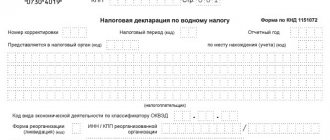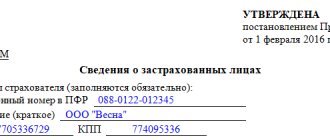Who are NPOs
NPOs, or non-profit organizations, are economic entities whose main purpose is to perform socially significant functions and programs.
But making a profit for this category of organizations is far from the first place. The concept and key features of the activity are enshrined in Federal Law dated January 12, 1996 No. 7-FZ (as amended on July 29, 2018). Despite their special status, like other economic entities, non-profit organizations are required to submit reports on the results of their activities. Moreover, such information will have to be submitted not only to the Federal Tax Service, but also to its founders, to territorial statistical bodies, as well as to the Ministry of Justice.
IMPORTANT!
It is NPOs that are required to report to the Russian Ministry of Justice. For example, such obligations are not provided for budgetary institutions or commercial firms.
https://youtu.be/2FDTLXjUiVk
What is this?
Next, we will look at what kind of reporting commercial organizations submit. But first, let’s define what exactly applies to them. An NPO is an institution whose purpose is not income. Profit received in the course of activities is not distributed among the founders.
You may be interested in:Petrodollars are... Concept, definition and history of the term
At the same time, NPOs have all the characteristics of legal entities:
- Having your own balance.
- The right to open bank accounts.
- Availability of stamps and seals with your name.
- Functioning on the basis of the charter.
- Establishment for an indefinite period of activity.
As a rule, NPOs are engaged in the following areas of activity:
- Social.
- Charitable.
- Cultural.
- Political.
- Educational.
All NPOs have one thing in common: they function to provide citizens with various public benefits. At the same time, Russian legislation does not prohibit NPOs from engaging in commerce. But only when the business activity is necessary to achieve the organization's goals. And the income is not subsequently distributed among its founders.
You may be interested in: What is qualimetry? Definition, basic concepts, types, methods
What kind of reporting do NPOs submit?
The reporting of non-profit organizations should be divided into separate groups:
- Tax - these are forms that are intended for the Federal Tax Service. Main goal: providing information to verify the correctness, completeness and timeliness of calculation and payment of tax payments. In simple words, these are declarations, advance calculations, certificates and explanations that allow tax authorities to check whether the company calculated the tax correctly and paid it in full to the budget, whether it correctly interpreted the legislation, and whether it lawfully took advantage of benefits, deductions and privileges.
- Insurance is information that discloses information about accrued and paid contributions in favor of insurance coverage for working citizens. This category of information is personalized information. That is, the report reveals the amount of insurance premiums accrued in relation to each employee of the company.
- Statistical is statistical reporting information that is systematically requested by territorial statistical bodies. This group of reports reveals almost all of the company’s performance indicators: production, labor resources, consumption, wages, working hours and much more. The composition of statistical reporting is quite large and is determined for each subject individually.
- Financial or accounting statements are data that disclose information about the financial position of the entity, the value of assets and the volume of liabilities assumed, and also characterizes the actual results of the organization’s activities. Analysis of reports in this category allows you to make management decisions.
We will talk about financial statements in this article.
Other papers for the tax authorities
In addition to the above, the tax reporting of non-profit organizations on OSNO is the following:
- Data on the average number of employees. The document is required if the NPO has more than 100 workers. Available until January 20 of the year following the reporting year.
- Help 2-NDFL. Russian legislation obliges each organization to provide a report on the amounts of income tax withheld from its employees. But only if there are more than 25 people. A certificate according to the established standard is submitted to the tax office before April 1 of the year following the expired reporting year.
Legal regulation of financial reporting
When preparing financial statements, an accountant of a non-profit organization should be guided by the following regulations:
- Order of the Ministry of Finance of the Russian Federation dated July 29, 1998 No. 34n.
- Order of the Ministry of Finance of the Russian Federation dated July 6, 1999 No. 43n.
- Order of the Ministry of Finance of the Russian Federation dated October 31, 2000 No. 94n.
- Order of the Ministry of Finance of the Russian Federation dated July 2, 2010 No. 66n.
When applying the rules of the above legislative acts, one should remember the features of non-profit organizations established by the Civil Code of Russia.
Firstly, NPOs were created not for the purpose of making a profit, but to achieve socially significant indicators, but they can conduct business activities if this is required to achieve their goals.
Secondly, non-profit enterprises do not have the right to distribute the income (profit) received between participants, founders, and owners, but direct it to achieve their goals.
Thirdly, on the basis of PBU 4/99, the financial statements of an organization (non-profit) should not contain information about the presence and changes in the authorized (share), reserve and other components of the organization’s capital.
Accounting in non-profit organizations not engaged in entrepreneurship
If an NPO carries out only socially fundamental activities, then this greatly simplifies the accountant’s work, since all receipts will be credited to the account. 86, and expenses - in the debit of the account. 86.
Account The NPOs we are considering do not apply 90. A count 91 is used only when conducting transactions for the sale of assets (paragraph 2, paragraph 1, PBU 9/99, paragraph 2, paragraph 1, PBU 10/99).
Below are the entries for the main operations carried out by non-profit organizations that are not engaged in entrepreneurial activities.
| Action | Dt | CT | Note |
| Target funds received and included in income | 07, 08, 10, 50, 51, 52 | 76 | VAT is not charged on target revenues (subclause 1, clause 2, article 146 of the Tax Code of the Russian Federation). If an NPO has several statutory types of activities, then 86 you need to open sub-accounts for each type. Targeted funds intended to cover administrative and organizational costs, in order to control them, also need to be transferred to a separate sub-account. 86 |
| 76 | 86 | ||
| The positive (negative) exchange rate difference from the revaluation of foreign currency is reflected | 50, 51, 52 (86) | 86 (50, 51, 52) | For the rules for calculating exchange rate differences, see the following articles: “What kind of posting generates negative exchange rate differences”; “Accounting for currency transactions (PBU, postings)” |
| Interest on target funds placed on deposits | 55 (58) | 86 | This income is not taxable (subclause 43, clause 1, article 251 of the Tax Code of the Russian Federation), therefore, in the accounting of non-profit organizations, it can be immediately attributed to an increase in target funds |
| Acquired fixed assets, intangible assets using targeted funds | 08 | 60 | The VAT paid when purchasing fixed assets is included in the cost of the fixed assets and is not accepted for deduction (paragraph 2, clause 4, article 170 of the Tax Code of the Russian Federation) |
| 01, 04 | 08 | ||
| 60 | 51 | ||
| 86 | 83 | The use of target funds in the form of investments in operating systems is reflected | |
| Accrual of depreciation of fixed assets | — | 010 | Calculation of depreciation of fixed assets is carried out using the linear method once a year during the period established by the classifier of depreciation groups (chart of accounts, paragraph 2 of clause 17 of PBU 6/01). There is no need to calculate OS wear and tear on a monthly basis. Depreciation is not calculated for intangible assets of non-commercial organizations (clause 24 of PBU 14/2007) |
| Disposal of fixed assets | 83 | 01, 04 | The book value of fixed assets and intangible assets was written off |
| OS sales | 50, 51 | 76 | OS buyer payment |
| 76 | 91-1 | When accounting for the sale of assets of non-profit organizations, they should be guided by PBU 9/99 and PBU 10/99 | |
| 91-3 | 68 | VAT is paid only on the difference between the sale value of the fixed assets and the balance sheet (rate 20%). You can find detailed explanations in the article “Calculation and procedure for paying VAT on the sale (sale) of fixed assets” | |
| 83 | 01 | Write-off of the recorded value of sold fixed assets | |
| 10 | 91-1 | The materials remaining from the written-off (sold) OS were capitalized | |
| Financial result from the sale of OS | 91-9 (99) | 99 (91-9) | Profit (loss) revealed |
| 99 (84) | 84 (99) | Profit (loss) is accounted for as undistributed | |
| 84 (86) | 86 (84) | Retained earnings (loss) are attributed to the increase (decrease) of target funds | |
| Recorded depreciation of fixed assets written off | 010 | — | Chart of accounts, paragraph 2 clause 17 PBU 6/01 |
| Organizational costs of non-profit organizations are reflected | 20, 26 | 68, 76 | Fees and other registration fees associated with organizing the activities of NPOs |
| 10 | 60 | Purchase of goods and materials and attribution of their cost to the implementation of the organizational activities of the non-profit organization (input VAT is included in the cost of materials) | |
| 20, 26 | 10 | ||
| 20, 26 | 69, 70, 71 | Salary and reporting expenses for employees organizing the activities of non-profit organizations | |
| 20, 26 | 76 | Rental of premises, consulting services and other organizational expenses (input VAT does not need to be allocated) | |
| 20, 26 | 68 | Property tax, land tax, transport | |
| 86 | 20, 26 | The use of targeted funds for organizational activities is reflected | |
| Targeted funds are aimed at the purposes for which the NPO was created | 86 | 76 | Funds can be transferred to both individuals and organizations |
| 76 | 01, 10, 50, 51, 52 |
Features of accounting and preparation of financial statements
Non-profit institutions, like other organizations, are required to keep accounting records in the prescribed manner (Law No. 402-FZ). Business transactions reflecting the activities of the enterprise are subject to reflection in primary documentation and registration journals. Financial reports are generated based on accounting data. Features of accounting, annual financial statements and methods of creating and detailing the accounting records of non-profit organizations must be reflected in the accounting policy.
IMPORTANT!
It is unacceptable to conduct accounting without an approved accounting policy. In simple words, without defining the main aspects and rules for reflecting and accounting for business transactions, it is impossible to achieve completeness, reliability and timeliness of data reflection. And therefore, it does not seem realistic to prepare truthful financial statements.
Accounting in NPOs, as in other categories of Russian organizations, is carried out exclusively in rubles. Even if the transaction was carried out in foreign currency, it must be converted into rubles. You should be guided by the basic rule of recalculation. That is, the operation is converted into rubles at the rate established by the Central Bank of Russia on the date of the operation. If determining the exchange rate is impossible or problematic, then a new procedure for conversion using the cross rate should be applied. But it is impossible to record a transaction in foreign currency. Consequently, accounting records cannot contain information and indicators calculated in foreign currencies.
Accounting for non-profit organizations engaged in business activities
Keeping accounting records for an NPO engaged in business is more difficult. Here, the accountant initially needs to set up strict control over the distribution of income and expenditures between socially basic activities and entrepreneurial ones.
First of all, you need to follow the wording of the purpose of the funds received and sent in contracts and primary documents. For example, the receipt of money by an NPO with the purpose of “Payment for holding a sporting event” will be regarded by tax authorities as taxable income. It would be more correct to indicate: “Targeted contribution for the organization and holding of a sporting event. NDS is not appearing". Moreover, the specified VAT mark is required.
The same goes for spending money. An accountant should avoid general statements. For example, instead of the purpose “Purchase of paper,” it is better to indicate “Purchase of paper for a charity drawing competition” or “Purchase of paper for the needs of the administrative department.” When maintaining accounting, such specific descriptions of the costs (payments) made will help to quickly distribute them between the correct accounting accounts.
Next, you need to carefully check the adequacy of the documentary justification for the costs incurred. Such justifications, in addition to primary documents, are:
- orders for distribution of funds;
- letters and orders of NPO participants;
- applications of citizens (organizations) to receive funds (assistance) from NPOs;
- other.
To separately account for costs for socially basic activities and entrepreneurial activities, you need to open the appropriate sub-accounts for cost accounts:
- 20-1 and 26-1 - for socially basic;
- 20-2 and 26-2 - for entrepreneurial.
The financial results of the NPOs under consideration are reflected as follows:
- from socially basic activities - on the account. 86;
- from entrepreneurship - to the account. 90, profit (loss) is written off annually to the account. 86;
- from the sale of assets (other transactions) - on the account. 91 with closing at the end of the year on the account. 86.
In the previous section, we already showed the entries compiled by non-profit organizations for socially fundamental activities and for the sale of assets. Now let’s look at the formation of transactions in an NPO for transactions related to its business:
| Action | Dt | CT | Note |
| Acquisition of fixed assets, intangible assets for business using targeted funds | 08 | 60 | VAT is excluded from the cost of fixed assets and intangible assets and is deductible provided that the fixed assets and intangible assets will be used in business activities subject to VAT |
| 19 | 60 | ||
| 01, 04 | 08 | ||
| 60 | 51 | ||
| 86 | 83 | The purchase of fixed assets and intangible assets at the expense of targeted funds is reflected | |
| Revenue from sales of goods and provision of services | 62 | 90-1 | Accounted for under the rules applicable to commercial entities |
| 90-3 | 68 | ||
| Costs associated with business are reflected | 20-2, 26-2 | 69, 70 | Costs of remuneration of employees engaged in business |
| 20-2, 26-2 | 10, 76, 60 | Costs for materials, services, work of third parties, individual entrepreneurs | |
| 19 | 10, 76, 60 | ||
| 20-2, 26-2 | 02, 05 | Depreciation of fixed assets, intangible assets involved in business | |
| Generating business results | 90-2 | 41, 43, 45 | Reflection in the results of the cost of purchase, production of goods sold |
| 90-2 | 20-2, 26-2 | Monthly attribution of incurred costs to financial results | |
| 90-9 (99) | 99 (90-9) | Monthly closing of the account balance. 90 | |
| 99 (84) | 84 (99) | The resulting profit (loss) at the end of the year is attributed to the increase (decrease) of target funds | |
| 84 (86) | 86 (84) | ||
| Purchase and sale of securities | 58 | 60, 76 | Purchase of securities. You can find detailed explanations on securities accounting in the following articles: “Accounting for financial investments - PBU 19/02”; “Accounting for securities in accounting (nuances)” |
| 60, 76 | 58 | ||
| 58 (91-2) | 91-1 (58) | Revaluation of securities (monthly or quarterly) | |
| 91-2 | 76 | Costs of brokerage, consulting and other services related to the circulation of securities | |
| 76 | 91-1 | Securities sold | |
| 91-2 | 58 | The book value of securities is written off | |
| Formation of results from transactions with securities | 91-9 (99) | 99 (91-9) | Profit (loss) revealed |
| 99 (84) | 84 (99) | Transfer of profit (loss) to the target funds account at the end of the year (activity) | |
| 84 (86) | 86 (84) |
Composition and structure of reporting forms
Annual financial statements for the enterprise are defined in Order of the Ministry of Finance No. 66n. The regulatory legal act establishes six reporting forms that will have to be filled out at the end of the calendar year. The financial statements of NPOs include:
- The balance sheet is the basis of financial reporting. A key document reflecting the value expression of the assets, capital and liabilities of the entity. The form is divided into two parts: passive and active. The active side of the balance sheet discloses information about the value of fixed assets, inventories, and financial instruments at the disposal of the company. The passive part of the balance sheet characterizes the sources of formation of assets, that is, the monetary expression of capital (authorized, additional, reserve), assumed liabilities (accounts payable, borrowed capital) and so on is indicated. The key rule of the balance sheet is that assets and liabilities must be equal.
- The income statement is the second most important form of financial reporting. Reflects the actual result of the company's activities. The structure of the document provides for filling in indicators not only for the reporting period (year), but also for the two previous ones. This feature allows for a comparative analysis of the enterprise’s activities by year.
- The statement of changes in capital discloses information about all capital movements that occurred during the reporting period. The information is filled out in the context of economically significant indicators, based on accounting data, for the full financial year.
- The cash flow statement details the flow of a business's financial assets. The structure of the form provides for the possibility of conducting a comparative analysis of the indicators of the reporting period and previous years (two previous calendar years).
- The report on the targeted use of funds provides information on the amount of targeted revenues (subsidies, grants, subsidies and other funds), as well as data on their use. Moreover, information about use is disclosed in the context of target areas. Filled out for the reporting and previous years.
- An appendix to the balance sheet is an explanatory note, as well as a set of forms and tables that reveal individual indicators about the activities, structure, and property assets of the enterprise. An explanatory note is a text description of the indicators of the reporting forms. Please note that if there are any discrepancies in the accounting statements, these circumstances should be disclosed in as much detail as possible in the explanatory note.
Current forms can be found in a separate material on accounting for non-profit organizations. For each report form, a brief commentary on how to fill it out is given, as well as current forms: accounting statements forms 1 and 2, a sample for them and other reports are available for download.
Simplified accounting reporting
NPOs, like other types of organizations defined in Law No. 402-FZ, have the right to conduct accounting in a simplified way. For “simplified” people, a shortened list of reports is provided.
But not every NPO can be considered one of the lucky ones that has the right to provide simplified forms. Legislators have approved special conditions for economic entities that can be considered “simplified”. Check to see if your company is one of these. All three conditions must be met:
- The organization's headcount should not exceed 100 people for the previous year. How to correctly calculate the population indicator is indicated in Rosstat Order No. 739 dated December 30, 2014.
- The share of participation in the authorized capital does not exceed the established standards. For public sector organizations, this indicator cannot be more than 25% of the capital of the non-profit organization, for foreign entities - no more than 49% of the capital of the non-profit organization.
- Income from business activities - no more than 800 million. A similar volume limitation is established for the residual value of assets - it cannot exceed RUB 800 million.
If the NPO meets the above conditions, then it has the right to conduct simplified accounting. This provision will have to be fixed in the accounting policy, and it is mandatory. Otherwise, when inspecting regulatory authorities, such as tax authorities, inspectors may request the provision of all forms of financial statements. After all, the organization did not stipulate in the UP that accounting is kept in a simplified form.
Simplified financial statements for 2020, KND 0710096 consists of:
- balance sheet;
- financial results report;
- report on the intended use of funds.
A report on financial results is not required for non-profit organizations that do not conduct business activities. For example, an organization operates at the expense of government subsidies, performs its assigned functions, but does not carry out entrepreneurial activities. Therefore, there are no indicators to fill out in form No. 2.
IMPORTANT!
The company independently determines the criteria for the significance of information for inclusion in reporting. The criteria should be fixed in the accounting policies to avoid disputes with regulatory authorities.
The specifics of filling out simplified financial statements are enshrined in Order of the Ministry of Finance No. PZ-3/2015. Let's define the key points:
- Financial information can be included in the statements without detailing the accounting items.
- Simplified reporting provides for the disclosure of less information compared to standard forms.
- Information about discontinued operations may be completely excluded from the reporting.
- Transactions made after the reporting date may also not be included in the report if they are considered insignificant.
Changes to the simplified tax system in 2020
Before switching to a simplified system in 2020, you need to familiarize yourself with the criteria that any organization, including a non-profit, must meet in order to take advantage of tax benefits:
- In accordance with paragraph 2 of Article 346.12 of the Tax Code of the Russian Federation, the organization’s income for 9 months of the previous 2020 should not exceed 112.5 million rubles.
- When calculating the amount of taxes, a deflator coefficient is not used, since the income limit is calculated by the rules described in Article 248 of the Tax Code of the Russian Federation.
- The amount of residual fixed capital according to accounting reports cannot exceed 150 million rubles.
- The number of hired employees, taking into account those who carry out their work duties in accordance with the GPC agreement, cannot exceed 100 people.
These rules apply not only to those organizations that are just planning to switch to a simplified special regime, but also to those LLCs and individual entrepreneurs that are already operating within its framework. If at least one condition is violated, the organization or individual entrepreneur is forcibly transferred to the main (standard) taxation system in the same reporting period in which the violation was committed.
Another important change within the framework of the simplified tax system in 2020 is the transition of existing simplified tax payers to the general regime for paying insurance premiums equal to 30%. This procedure is established by subparagraph 3, paragraph 2 of Article 247 of the Tax Code of the Russian Federation. However, local governments in the regions of Russia have the right to reduce the tax rate, and this happens in accordance with the legislative charter at the municipal level.
Important! The Ministry of Finance of the Russian Federation announced that for the period 2020-2021, the abolition of the simplified tax system 6% (“Revenue”) regime for organizations and individual entrepreneurs using new generation cash register equipment (online cash registers) is being considered.
Reporting to the Ministry of Justice
Accounting reports are sent to the Federal Tax Service and Rosstat and to the Ministry of Justice. Unlike commercial firms and public sector institutions, NPOs are the only ones who must submit information to the Ministry of Justice.
For reporting to the Ministry of Justice, special unified forms have been approved, different from tax reporting forms. The forms are enshrined in Order of the Ministry of Justice of Russia dated August 16, 2018 No. 170.
NPOs are required to publish information about the continuation of their activities in a timely manner. Moreover, publications must be posted on the Internet in the public domain or in special media.
There are several ways to submit information to the Ministry of Justice:
- by post, be sure to make an inventory of the attachment with a list of all attached forms;
- via email, but sent reports must be signed with an electronic digital signature;
- by posting it independently on the Internet, on sites that can be accessed directly through the website of the Ministry of Justice;
- providing information for publication in the media.
The reporting forms include:
- Report on the activities of a non-profit organization and on the personnel of its governing bodies (Form No. ON0001).
- A report on the purposes of the non-profit organization's expenditure of funds and the use of other property, including those received from foreign states, their government bodies, international and foreign organizations, foreign citizens, stateless persons or persons authorized by them and (or) from Russian legal entities receiving cash and other property from the specified sources (form No. ОН0002).
Submit information annually, before April 15 of the year following the reporting year. Depending on the form and type of NPO, legislators have provided for additional reporting. All forms are enshrined in Order of the Ministry of Justice of Russia dated August 16, 2018 No. 170.
Reporting methods
- Personal delivery of the report.
- Sending by mail.
- Sending by email. Possible with an electronic digital signature of the head of the non-profit organization and the accountant.
- Publication of reports and results of activities on the official website of the Ministry of Justice of Russia.
- Publication of reports in the media or on your own website on the Internet (with the exception of personal information about participants and managers of NPOs).
Deadlines for submitting financial statements
Reports on the financial activities of NPOs should be submitted to the territorial office of the tax inspectorate, statistical monitoring bodies and other government agencies upon official request.
Moreover, the manager or chief accountant does not have the right to refuse to familiarize third parties with the financial statements. Financial statements must be submitted no later than 90 calendar days from the end of the reporting period, that is, before March 31 of the following year. An exception is the reorganization of the enterprise. For example, an NPO is liquidated in September of this year, therefore, financial statements are prepared for the 4th quarter of 2020 (separation balance sheet).
In general, submit information to the regulatory authorities no later than April 1. If the last day for submitting reports (March 31) falls on a non-working day, then the deadline is postponed to the first working day.
The founders of NPOs have the right to demand the provision of accounting records within the approved time frame. For example, the owner has the right to request a completed report as early as January. Such situations are more typical for organizations whose founders are public sector institutions. State employees generate reports in a special manner, therefore, the deadlines for them are determined individually.
The founder must, in the prescribed manner, inform the organization of the requirement to provide financial statements. Moreover, the responsible persons will have to be notified against signature. Otherwise, requiring a report before the deadline is unacceptable.
Tax documents: OSNO
NPOs are not exempt from submitting reporting documents to the tax service. The form of reporting for non-profit organizations depends on the tax regime chosen by the institution.
If the NPO is on the OSNO (general regime), then it needs to provide the following to the Federal Tax Service:
- VAT declaration. The documentation is submitted to the addressee in electronic form no later than the 25th day of the month following the reporting period.
- Property tax declaration. If an NPO has any taxable property as part of its assets, it provides the corresponding calculations and pays tax contributions every quarter of the year. Only those NPOs that do not own fixed assets are exempt from filling out a declaration and paying such tax. A declaration-report on advance payments is submitted to the tax authorities within 30 days after the end of the tax period. A document with information about the final calculation must be sent to the Federal Tax Service no later than March 30 of the year following the reporting year.
- Income tax return. An NPO will be recognized as a payer of this fee if it is engaged in business. Such a document is submitted at the end of each reporting period - no later than 28 days before its end. The report for the full tax period is submitted before March 28 of the year following the reporting year. If the NPO is not engaged in business, it submits a tax return to the department in a special simplified form. The critical deadline for its submission is also March 28 of the year following the reporting period.
- Land tax declaration. Accordingly, such reporting by non-profit organizations is needed only if they own a plot of land. The document is submitted to the Federal Tax Service no later than February 1 of the year following the reporting year.
- Declaration of transport tax. Again, this form of reporting for non-profit organizations is only necessary if they own any taxable vehicles. The document must also be submitted before February 1 of the year following the reporting year.
You might be interested: QA Engineer - what does it mean? Pros and cons of the specialty
Control and audit
Financial audit of accounting is an independent assessment of the completeness, correctness, reliability and legality of accounting and reporting. Moreover, only specialized audit organizations or private auditors who have passed licensing have the right to conduct an audit of accounting reports.
A non-profit enterprise, like a public sector institution, does not belong to an organization whose financial statements are subject to mandatory audit. However, the founder (owner, supervisory board, supreme management body) of an NPO may decide on the need to conduct an audit to conduct an expert assessment and obtain a reliable conclusion about the quality of accounting in the organization.
In this case, the procedure for conducting an audit must be developed and communicated to interested parties. The duration of the event, areas of accounting, and a list of documents that will be subject to control must be specifically defined.
Socially oriented group
First of all, let's figure out which NPOs are socially oriented non-profit organizations. These are institutions dealing with the following public issues:
- Social protection.
- Assistance to the population affected by man-made disasters and natural disasters.
- Animal protection.
- Protection of various structures and buildings of historical significance.
- Providing free or preferential legal assistance to citizens.
- Charity.
- Solving environmental problems, environmental protection.
- Preventive measures to eliminate socially dangerous behavior of citizens.
- Development of activities in the fields of culture, healthcare, science, education.
The majority of SO NPOs are represented by the following institutions:
- Public and civil associations.
- Religious organizations.
- Autonomous NPOs.
- Political parties.
- Selected government agencies.











